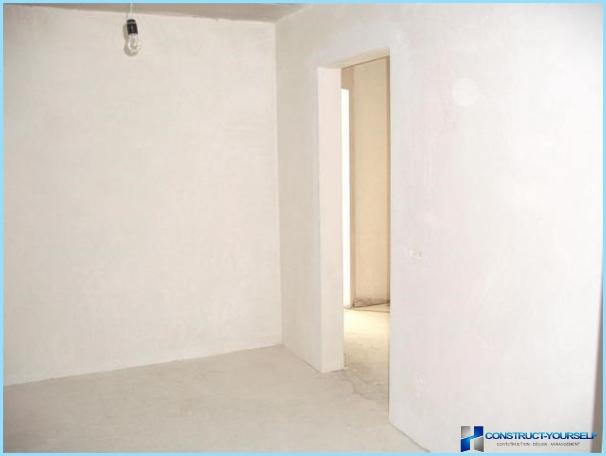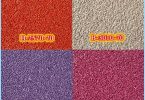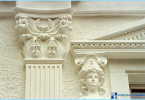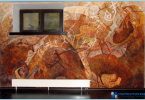The contents
Quite rare to find in a new apartment or a newly built cottage walls or ceiling that are perfectly smooth and do not require plastering. As for premises operated for quite a long time, the old plaster is usually a lot to be desired – loose, crumbling and in some places completely detached from the base. Adds «negative» and fungus, which manifests itself in the form of greenish streaks. All this allows us decorate the room, for example, for painting and putting up Wallpaper does not bring any long-term result, and using a small amount of time redecorating is necessary to spend anew.
Gypsum plaster is a generic way to transform a room ↑
What gypsum plasters are the most popular for interior applications in residential premises, because they have undeniable advantages over the line on a different basis:
- full environmental safety due to the fact that used as the basis of natural gypsum, which is absolutely harmless to humans;
- ease of preparation of the solution – water is added in accordance with the instructions on the package, and mixing is carried out by drill with a special nozzle-mixer;
- great time working with the prepared solution (usually at least 90 minutes);
- high elasticity of the finished composition, which gives the opportunity to work with him an inexperienced person;
- the walls, plastered with plaster of Paris, contribute to the maintenance of optimal indoor climate, and can adjust the humidity in it, absorbing the excess, and «giving» its in the drying air;
- the wall surface after drying, the plaster is white or light gray color;
- easy grinding of the abrasive composition of such nets;
- the possibility of pasting the Wallpapers without pre-shpatlevanie finishing putty;
- good adhesion to any grounds.
Naturally, before plastering with stucco, any surface must be previously prepared, and the quality will be carried out this step, the higher will be the end result.
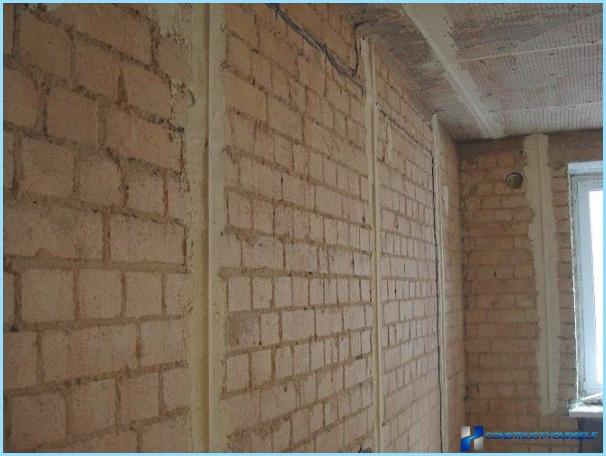
Preparation of walls for plastering – what to pay attention ↑
Before plastering walls with gypsum plaster must be thoroughly remove old finish (Wallpaper, paint). The wall must be dry. Thoroughly «to tap» the wall, designed to handle, which is convenient to use a small hammer. With its help easily identify areas where the old plaster has started to peel away from the wall – this is necessary to completely recapture, because their presence will lead to the inevitable formation of cracks in newly plastered wall.
The next stage of training is the identification and elimination of foci of reproduction of fungi (molds). Action here will require radical, even if the old plaster is held firmly, it must be completely (to masonry) to remove from the wall. After that, you will need treatment with special antifungal composition, preferably twice. After drying, the entire surface of the wall should be treated with acrylic primer of deep penetration – if the wall is loose and easily crumbles, it is necessary to ground a in 2-3 layers with intermediate drying each for 1.5-2 hours.
In some cases, when you need plastering walls with gypsum plaster, but the old plaster layer is still quite durable, and painted with alkyd enamel, a task seriously complicated, because to fully remove the paint will be incredibly difficult. In this case there is a simpler way to handle the wall with primer «Beton-contact», which is a suspension of quartz sand in an acrylic binder. After drying, the surface of the wall reaches the desired roughness, which will be easy to keep the new layer of plaster.
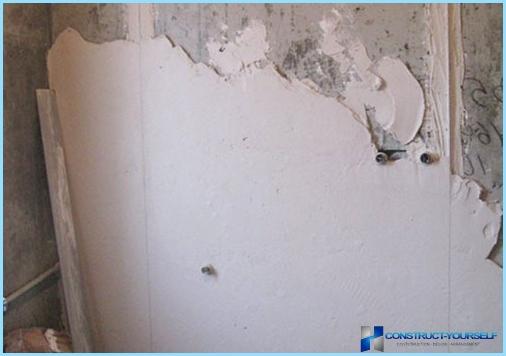
Plasterer? wall with their hands ↑
Many fear that the plaster will be fragile or inappropriate in some cases, and wonder whether it is possible to plaster, gypsum plaster in the bathroom, or use it for unheated cottages – the answer is unequivocally Yes. In order for the result of the work was optimal, and «new» the walls were perfectly smooth, the plastering should be carried out by special beacons. It guides galvanized steel/aluminium that allow you to create a uniform layer of plaster, and greatly simplify and speed up the work process.
Beacons are precut at the height of the wall. Then, starting from one of the corners of the room begins the process of their installation. It is easier to do with the use of alabaster (hardening time which is 5-7 minutes). Alabaster spankings applied to the wall (2-3 places), after which it is pressed vertically into the lighthouse and is aligned to the level of construction so that was strictly vertical. The preferred use of 2-meter level. The next lighthouse is set on the distance from the first, what length is used the rule. Beginners will be easier to work with rule with the length of 1-1,5 meters.
Once all the beacons are installed, issues like plastering on beacons plaster plaster almost does not occur, because the further process is quite simple. Cooked pounces on the wall of the building with a bucket of suitable size from bottom to top. After having closed the wall surface height of about one meter, rule plaster layer to be trimmed (also, starting from the bottom) – the very rule, while sliding over the beacons. The result is a fairly smooth layer, and in the formation of small pits, you can fill them with a spatula.
If necessary, the dried surface you can start to wipe the plastic or steel trowel, soaking it in the water. Thus, with sufficient skill it is possible to obtain an almost perfect, glossy surface. Thus, the question of how to plaster, gypsum plaster, is not so difficult as it might seem at first glance.
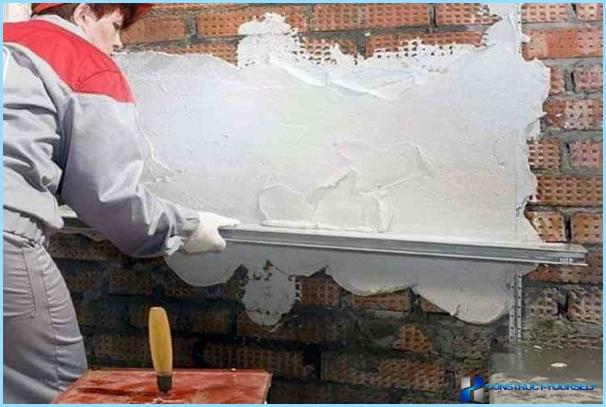
What can be plastered with a plaster mix ↑
The versatility of gypsum compositions, creates the impression that they can be used almost everywhere. It is not so, and answer, for example, on the question whether it is possible to plaster the oven with stucco will be unambiguous «no», because it is not designed for surfaces subject to temperature extremes. However, it is possible to plastering drywall and polystyrene gypsum plaster, and allowed its use is not concrete or brick walls.
In many ways, such opportunities due to members the composition of the mixture of polymer and plasticizing additives, providing excellent adhesion to the above reasons. It is worth noting that despite this, the plaster reinforced concrete foam polystyrene or desirable to keep with pre-installation of steel or plastic plaster mesh – it will greatly increase the strength of the surface, preventing the formation of cracks in it. It is worth noting the opportunity to plastering of the ceiling plaster at the same time, particularly pleased with the fact that it is possible to apply a thick enough layer in one pass, which will allow to hide serious defects.
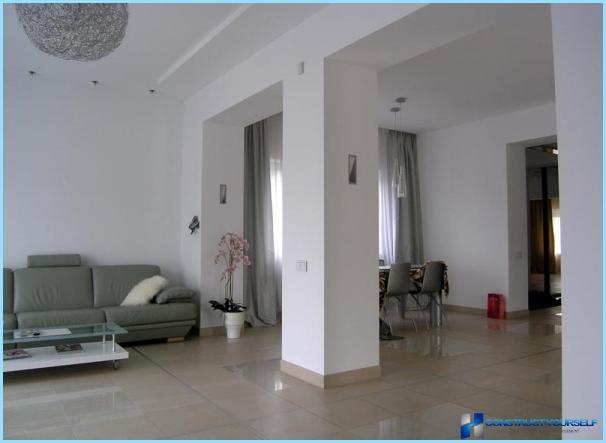
An important feature of plastering the walls with stucco is the fact that after application and proper rubbing/sanding the wall can be directly Wallpaper (after treatment with primer), without prior taping. Using, for example, cement composition, this will not allow, especially if the Wallpaper is thin and light.
About how to plaster walls, gypsum plaster is shown in the video
The gypsum composition can be used practically throughout the house, with the exception of its facade, since the constant changes in temperature fast enough will lead to cracking of the plaster layer and its shedding.

